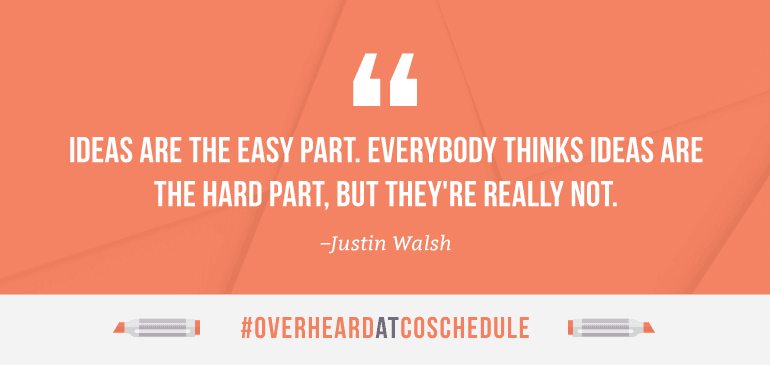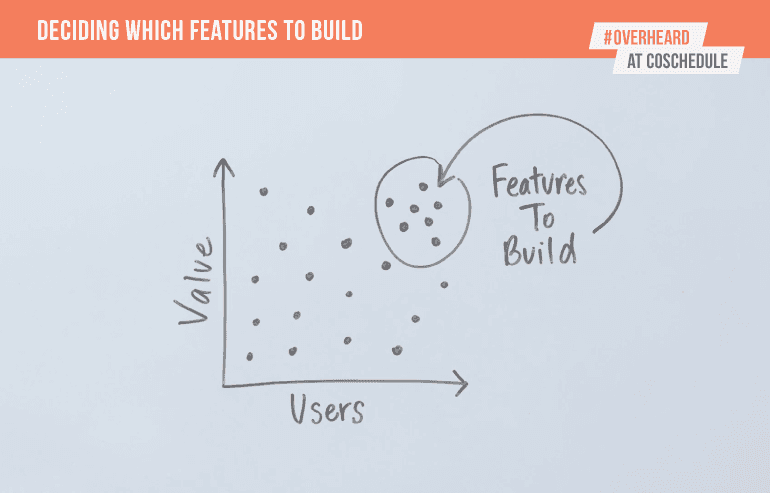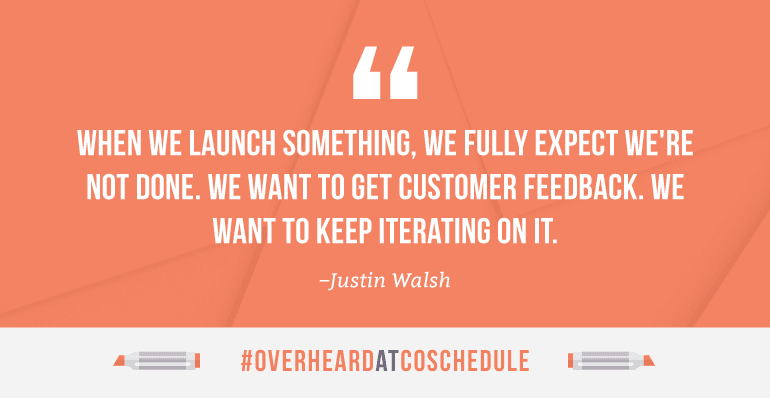How To Prioritize Projects (AKA: How CoSchedule Prioritizes The Features You Love) | #OverheardAtCoSchedule
 If you’re a software or technology company, feedback from your audience and customers is invaluable. You want to know what they like, what they don’t, and which features they’d like you to build in the future. You probably have ideas of your own you’d like to implement, too.
So, how do you prioritize projects when you have more ideas than you can build right now?
On this episode of Overheard At Schedule, company co-founders Garrett Moon and Justin Walsh discuss how CoSchedule blocks out the noise and decides which features to build. You’ll learn how to score ideas to weed out duds. Then, you’ll discover how to develop actionable product road maps, and turn your ideas into real features customers can actually use.
If you’re a software or technology company, feedback from your audience and customers is invaluable. You want to know what they like, what they don’t, and which features they’d like you to build in the future. You probably have ideas of your own you’d like to implement, too.
So, how do you prioritize projects when you have more ideas than you can build right now?
On this episode of Overheard At Schedule, company co-founders Garrett Moon and Justin Walsh discuss how CoSchedule blocks out the noise and decides which features to build. You’ll learn how to score ideas to weed out duds. Then, you’ll discover how to develop actionable product road maps, and turn your ideas into real features customers can actually use.
How To Prioritize Projects (AKA: How CoSchedule Prioritizes The Features You Love)
Click To TweetPhase #1: Score Ideas By Number Of People Who Will Get The Most Value
Justin: Right. Ideas are the easy part. Everybody thinks ideas are the hard part, but they're really not. We've got all kinds of different areas of the company constantly collecting product feedback from our customers. Whether they're new customers or customers we've had for a long time or just our product team. Garrett: Our marketing team who uses it everyday and our support team.
Justin: We'll get thousands of ideas, right? Hundreds of thousands of ideas. We get just so many things and we've got to figure out what are we going to build next?
Garrett: Yeah. Okay, tons of ideas. Those are easy. How do we do it? How do we whittle that down?
Justin: We tried a bunch of things and what worked the best for us is these product roadmap summits where basically we take all these ideas, we put them on Post-it notes, and we put them up on the wall, and our entire team meets and says, "What's the most important thing to our customers to build next?"
Garrett: Yeah. I always think one of the things that you do at those roadmap summits that's always so useful is you love to draw this X, Y chart that helps us zero in on it really quickly.
Justin: It's a simple chart. Basically, it's how many customers will this feature be used by and how much value will they get from it? We're always looking for things that are up and to the right, which means a lot of people ...
Garrett: Our marketing team who uses it everyday and our support team.
Justin: We'll get thousands of ideas, right? Hundreds of thousands of ideas. We get just so many things and we've got to figure out what are we going to build next?
Garrett: Yeah. Okay, tons of ideas. Those are easy. How do we do it? How do we whittle that down?
Justin: We tried a bunch of things and what worked the best for us is these product roadmap summits where basically we take all these ideas, we put them on Post-it notes, and we put them up on the wall, and our entire team meets and says, "What's the most important thing to our customers to build next?"
Garrett: Yeah. I always think one of the things that you do at those roadmap summits that's always so useful is you love to draw this X, Y chart that helps us zero in on it really quickly.
Justin: It's a simple chart. Basically, it's how many customers will this feature be used by and how much value will they get from it? We're always looking for things that are up and to the right, which means a lot of people ...
 Garrett: All right, so the higher up to the right, it's more value, more customers.
Justin: Exactly.
Garrett: Less value, less customers down at the bottom. You draw the line, now you have the priority.
Justin: Yeah, exactly. It allows us to cut that list down very quickly.
Garrett: Yeah. Okay, now transitioning that to actually building it, the montage moment. The Facebook Social Network movie, the five years where they actually grew, that was 30 seconds of music. Cue the music.
Justin: Cue the Rocky music.
Garrett: How is it built?
Garrett: All right, so the higher up to the right, it's more value, more customers.
Justin: Exactly.
Garrett: Less value, less customers down at the bottom. You draw the line, now you have the priority.
Justin: Yeah, exactly. It allows us to cut that list down very quickly.
Garrett: Yeah. Okay, now transitioning that to actually building it, the montage moment. The Facebook Social Network movie, the five years where they actually grew, that was 30 seconds of music. Cue the music.
Justin: Cue the Rocky music.
Garrett: How is it built?
Phase #2: Break Up The Ideas Into Specific Product Roadmaps
Justin: The product team breaks it up. We have a number of product teams that have designers and engineers and product managers on them that take that roadmap, a part of it, and they own it. They're going to build feature after feature until we finish the roadmap. Garrett: I think currently we're at ... We have about four roadmaps and four roadmap teams that break it down based on the type of feature that it is and they're building out at any time. Justin: That's exactly right. Garrett: Launch time comes, now what?Phase #3: Launch + Iterate
Justin: Right. When we launch something, we fully expect we're not done. We want to get customer feedback. We want to keep iterating on it. We put a dedicated team aside just to make sure that that feature launches well, that the customers get really good support, and that we can change it very, very quickly even if that means pushing the production everyday just to make sure we got the feature right. Garrett: Yeah. I think that works really well. I love that launch week. There's always these things, these realizations that our customers have that we didn't see coming, we didn't think of it, but they're always really good to tell us and I love that we're able to incorporate it pretty quickly.
Justin: Right. We almost always have cake in the office on launch week, so that's a huge bonus.
Garrett: Right. That's huge, is the cake. All right, so that is how we decide what to build at CoSchedule. Obviously, your feedback matters a ton to us. Keep it coming. That's Overheard at CoSchedule.
Garrett: Yeah. I think that works really well. I love that launch week. There's always these things, these realizations that our customers have that we didn't see coming, we didn't think of it, but they're always really good to tell us and I love that we're able to incorporate it pretty quickly.
Justin: Right. We almost always have cake in the office on launch week, so that's a huge bonus.
Garrett: Right. That's huge, is the cake. All right, so that is how we decide what to build at CoSchedule. Obviously, your feedback matters a ton to us. Keep it coming. That's Overheard at CoSchedule.
Learn how to ship new features the CoSchedule way #OverheardAtCoSchedule
Click To Tweet

